One of the main reasons we wanted to spend some time in the Costa Brava region of northeast Spain was to visit some very special sights associated with the Spanish artist Salvador Dali. We drove to Figueres from nearby Roses, our base in the area, to see the Dali Theater-Museum. I loved this Dali-inspired roundabout as we neared Figueres.
The Dali Square dated from 1850 and was built on the site of a former cemetery and was then located in a building that was once the Municipal Theater of Figueres. Dali had his first show there when he was just 14 and he was baptized in the church just across the street.
After the theater was partially demolished during the Spanish Civil War and later burned down by pro-Franco troops in 1939, Dali made a deal with the mayor. Dali would rebuild the theater as a museum honoring his work rather than in the nearby big city of Barcelona, thereby putting Figueres on the sightseeing map.
Below the ring of statues was Dali's own 1941 Cadillac. You know how it seems you can never get a cab when it's raining? Well, Dali made it so, when we popped a euro into the slot, it rained inside the car and music played! I thought that was so cool!
A painting of Galarina or Gala, Dali's muse whom he met when he was 25 and she was 35 and married.
Barcelona Mannequin was painted in 1934.
Dali's first solo exhibition was in Barcelona at the age of just 21. According to the notes I read, the paintings showed two aspects that would alternate and complement one another throughout his career: a return to order and tradition, and a search for the most experimental.
The Pomegranate Heart was also done in 1949.
Next post: Exploring more of Costa Brava later that afternoon.
Posted on December 7th, 2018, from Lisbon, Portugal.
Another interesting roundabout in Figueres itself:
More Dali-inspired art outside the museum:
When we entered the courtyard, the first thing we saw was an audience of gold statues that looked like the Oscars!
Below the ring of statues was Dali's own 1941 Cadillac. You know how it seems you can never get a cab when it's raining? Well, Dali made it so, when we popped a euro into the slot, it rained inside the car and music played! I thought that was so cool!
It was sort of hard to ignore the buxom woman behind Dali's car!
Above another tire tower was the boat Dali enjoyed with his soul mate and later wife, Gala, who was seen as his emotional life preserver. Blue tears, made of condoms, dripped below the boat representing Dali's grief after Gala died.
A massive geodesic dome bathed the theater with light.
As I knew that much of Dali's art was movable and coin-operated, I looked for another fun way to spend some money! I was glad to spend the equivalent of just a quarter to watch this 'thing' expand and contract a couple of times.
Only with my camera was I able to clearly see the image of President Abraham Lincoln. Without it, Abe's facial cheeks were Gala's butt cheeks. Luckily, there was a note on a wall telling people to look at the image through their camera lens or the telescope to 'see' the art work.
The sculpture underneath was a play on the Lincoln Memorial.
The Treasures Room had the museum's biggest collection of Dali's oil paintings.
How did Dali ever think of naming this work Inaugural Goose Flesh, I wondered?
A painting of Galarina or Gala, Dali's muse whom he met when he was 25 and she was 35 and married.
There were Cubist visions of the home Gala and Dali shared in Cadaques, near Figueres. Steven and I were looking forward to visiting the home the following day.
This painting reminded both Steven and me of the Statue of Liberty.
This is the style of art normally associated with Dali.
Barcelona Mannequin was painted in 1934.
One of Dali's most important paintings was Imperial Violets done in 1938 at a time of great turmoil in Europe: Spain was in the middle of its Civil War and WWII could be seen on the horizon. The darkening color range in his paintings reflected what was happening at home and in the rest of Europe. The disconnected telephone spoke of the lack of communication among the leading European powers and the approach of war.
In the artist's crypt were marvelous golden sculptures and jewelry Dali designed.
The pendant included Salvador and Gala's initials.
His mausoleum was also in the crypt. I never read where Gala was buried, though.
In an exhibition of paintings by Evarist Valles, the artist used lots of nails in the works. I wondered why.
Of less interest to me were Dali's drawings and graphic illustrations but they demonstrated his breadth as an artist. Dali was also a film maker, collaborating on a film with Luis Bunuel and designing the big eye backdrop for Alfred Hitchcock's dream sequence in Spellbound. He designed clothes for Coco Chanel, wrote a novel and an autobiography and helped develop 'performance art.'
Another sculpture reminiscent to me of the Lincoln Memorial: Salvador and Gala spent the WWII years in the US so that may explain his affinity with American politicians.
Dali's Homage to Mae West room was a tribute to the sultry seductress. Look at his fireplace nostrils and sofa lips!
I wasn't sure what exactly I'd see when I climbed the steps in the Mae West room but was very curious to find out.
It was only when I looked through the camel that the disparate parts came together to make the face of Mae West with the paintings being her eyes! What a fantastically creative mind to come up with this stuff!
Looking outside in: one of the gold statues we'd seen upon entering the theater.
A collection of paintings by Antonin Pixtot were made from images of rocks placed together in unusual forms.
Another view of the massive tire sculpture in the square outside the museum:
The former theater's smoking lounge was a museum highlight. The ceiling painting showed Dali's and Gala's feet as they bridged the earth and heavens!
It was amazing to think Dali's 1925 oil painting, Figure in Peril, was hidden away from public view for the past 92 years. It was of his sister who was his main model when he was learning his craft. How privileged we were to see the painting.
I was reminded that during the Renaissance, great artists didn't restrict themselves to a single medium. Da Vinci's genius soared beyond the confines of a picture and Botticelli and other artists created gems for adornment, goblets and chalices. You can see that Dali followed suit by creating masterpieces contained in the Jewels Exhibit. The Eye of Time from 1949 was the earliest piece.
The Pomegranate Heart was also done in 1949.
Necklace with Entwined Limbs was created in 1964.
Dali designed Swan Lake in 1959.
In his piece called Pax Vobis or Peace to You created in 1968, the door opened and closed, without any money needed to be put in this time!
When the door was open, it appeared to reveal the face similar to Mona Lisa's!
It was hard to think we'd just spent well over two hours in the museum as it'd gone by so quickly. As we'd entered from the back, we were captivated seeing the pink facade studded with golden loaves of bread and topped with monumental eggs. It meshed perfectly with the fantastical, surrealist look that has become synonymous with Dali! The best description I read was "The museum wasn't just a home for much of Dali's life work, but a sort of artistic carnival, filled with all manner of surprises and illusions." I can't remember the last time I had so much fun in a museum, if ever, as I did in the Dali Theater-Museum!
Next post: Exploring more of Costa Brava later that afternoon.
Posted on December 7th, 2018, from Lisbon, Portugal.




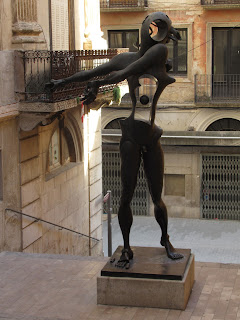











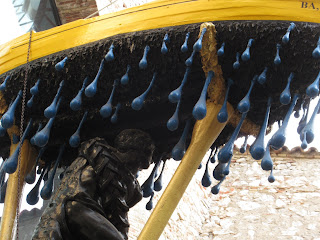































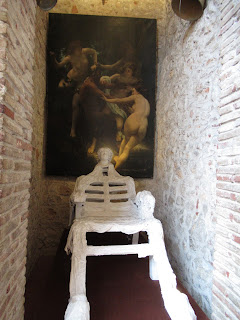





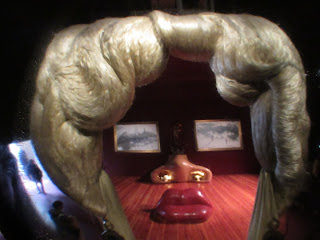







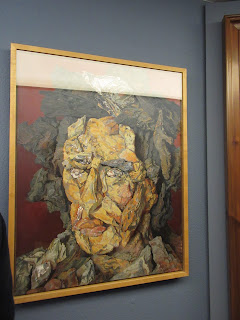

























No comments:
Post a Comment